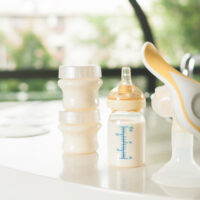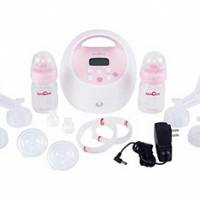Sometimes newborns, especially those in the first few weeks of life, can be “sleepy eaters.” These little ones have a hard time staying awake for a full feeding. Consequentially, these sleepy little friends do not fill up their tummies during a feed and will need to eat again every hour, if not more frequently.
It is important to make sure baby gets a full feed before dozing off. If your baby falls asleep after feeding for less than 1o minutes, they likely did not get enough milk. If baby is frequently falling asleep before getting a full feed, they will have trouble sleeping soundly and will need to eat more frequently.
Keeping a Baby Awake While Breastfeeding
Here are a few tips to keep your baby awake to make sure they get enough milk during a nursing session:
- Strip baby down to his diaper The skin to skin contact might help baby stay awake and focused on eating.
- Turn on the lights Brightening up the room by turning on lights or opening shades can stimulate baby and promote wakefulness while eating.
- Stop and switch sides if you notice your baby is getting very drowsy.
- Change baby’s diaper The cool air and change in position will likely wake baby, after which you can offer the other breast
- Try to burp baby Changing his position and gently patting on his back will help rid his tummy of excess gas and help wake him up.
- Sing or talk softly to your baby Your voice is stimulating to your baby, and hearing you speak or sing a soft tune can help him stay awake to finish feeding.
- Try breast compression If you are worried that your newborn is not getting enough milk, try making a C shape with your thumb and fingers and gently compressing you breast as your baby eats. This can help keep the milk flowing and make sure Baby is eating.
- Gently rub a wipe or wet cloth on baby’s face or back The cool sensation will help him stay awake enough to get a full feed.
These tips should help make sure that your newborn stays awake long enough to nurse for at least 15 to 20 minutes. If you have any concerns about your baby’s weight gain or are unsure if he is getting enough milk, consult his pediatrician as soon as possible. Your pediatrician can monitor baby’s weight to make sure he is eating enough and his growth is on target.
How To Tell If Your Baby is Getting Enough Milk
Many parents worry about their babies taking in enough milk during breastfeeding. Unlike bottle feeding, breastfeeding can be tricky because it is difficult to know exactly how much milk baby is ingesting.
Here are a few signs to look for that show your baby is taking in milk:
- Regains birth weight Newborns lose up to 10% of their birthweight shortly after they are born. At your first pediatrician appointment (within 5 days of giving birth), he should be gaining weigh since leaving the hospital. If not, your doctor will likely recommend weight checks.
- 6 or more wet diapers a day
- 3 to 4 bowel movements a day A few days after birth, baby’s stools will change from dark, tarry meconium to liquid, yellow, and seedy.
- Seems satisfied after feeding for 15 to 20 minutes
A visit to an IBCLC, or board-certified lactation consultant, can be very helpful during the early days of breastfeeding. The lactation consultant can do what is known as a weighted feed. This involves weighing your newborn before and after a nursing session to see how much milk he took in. This can be helpful and even reassuring for new mothers.
Remember, it is perfectly normal for newborn babies to breastfeed quite often. Babies under 3 months should not be put on a feeding schedule. Instead, parents should feed babies on demand. Once baby is older and eating solid foods in addition to nursing (usually after about 4 to 6 months of age) he will be better able to nurse on a flexible schedule.
How to Know If Baby is Getting a Good Latch
If your newborn baby is frequently falling asleep before getting a full feed, it might be a good idea to check his latch. If he is not properly latched onto the breast, he will not take in milk efficiently. He may also get overtired and fall asleep before he finishes eating.
If you are concerned that your infant might not have a good latch when he nurses, you will need to visit with a lactation consultant. He or she will be able to observe you nurse your baby. If there is an issue with baby’s latch, a lactation consultant can help you take steps to correct it.
Sometimes something as simple as changing the way you are holding your baby during breastfeeding can be enough to fix the latch. Nipple shields are another option for babies who have trouble latching on. An IBCLC can discuss all these options with you and help you arrive at a solution that works for both you and your baby.
A Guide to Infant Sleep Routines
During the first few weeks of life, newborns will generally sleep around the clock in 2-3 hour spurts, waking to feed. After about a month, you will notice that your baby is staying awake for longer periods. You will want to be careful to make sure that your baby is not staying awake for too long in between naps, as it is important for him to get adequate rest.
Typically, newborns, or babies under 3 months of age, will sleep for about 14 to 18 hours total throughout the day. They may be awake between naps for 1 to 2 hours. It is very important to follow your baby’s sleepy cues and put him down for a nap when he begins showing signs of tiredness.
Here are some sleepy cues to look out for:
- rubbing eyes
- yawning
- decreased movement
- crying or becoming fussy
Keep in mind that crying is a late sleepy cue, meaning baby is close to becoming overtired at this point. It is best not to wait until he is extremely fussy before putting him down for a nap. Try to keep an eye out for other cues so you can put him down before he gets overtired.
Making sure baby is getting enough rest can prevent him from falling asleep before finishing a feed. It will allow him to stay awake for a full feeding, which in turn will help him have a full tummy and sleep for longer stretches of restful, restorative sleep.
Sleep Routines After 3 Months
At 3 months old, your baby is no longer a newborn. He is likely beginning to sleep for a bit longer stretches at night, and he may be napping for longer periods during the day. At this point, your baby is likely ready to begin following a daily sleep routine. Here is a helpful video explaining how to get your 3-month-old baby accustomed to a sleep schedule.
At 3 months old, it is a good idea to put your baby down for a nap or for night sleep when he is drowsy, yet awake. This will prevent him from needing to be fed or rocked in order to fall asleep. When he awakes from a nap, it will be time to eat.
During the day, you will want to help your baby get into a pattern of Eat, Play, Sleep. Upon waking, he should be fed until he is full. Rather than letting him fall back asleep immediately after eating, try to keep him awake for a while. You can engage in one of the following activities to keep him awake and alert:
- Have tummy time on the floor
- Lay him on his back and play with some dangling toys
- Read him a story
- Give him a bath
- Walk him around the house and talk about what you see
After about 45 minutes to an hour, or sooner if you notice he is showing sleepy cues, you can begin getting him ready for his first nap of the day. This routine will definitely take some getting used to, for both you and your baby. But it can also help him become a better and more independent sleeper.
How to Get a Baby Ready for a Nap
All children, even young infants thrive on routine. You should have a nap and nighttime ritual that is the same every time baby goes to sleep. This helps him know what to expect and understand that it is time for sleep.
Using some simple techniques to help baby calm down, relax, and get ready for sleep can be highly effective. We recommend including some or all of the ideas below into your bedtime ritual.
- Diaper change
- Soft music
- Swaddle or sleep sack, depending on Baby’s age (never use a swaddle after Baby can roll over)
- Dim the lights
- Read a story
- White noise machine
- Rock in a rocking chair or glider
Whether you are reading, singing, or rocking before sleep, you will want to stop when your baby is getting drowsy. If his eyes are just beginning to droop, but he is not yet asleep, this is the ideal time to put him down in his crib or bassinet. Gently lay him down on his back in his sleep space. With some practice, he will learn to fall asleep on his own.
Helping Your Breastfed Baby Sleep Longer at Night
You may be concerned about your baby staying awake to feed if he is not getting adequate nighttime sleep. Many parents of infants under 4 months old wonder how they can help get their baby to sleep for longer nighttime stretches. Breastfed babies in particular tend to wake frequently to feed at night, which can be very exhausting for Mom.
Luckily, there are strategies you can try to get your little one into the habit of better nighttime sleep. One study found that there are a few things parents can do to help their little ones sleep better at night:
- Offer a “focal feed” – Gently rousing your baby and offering a feed between 10 pm and midnight. You do not need to fully wake up your baby for this. Simply take him out of his bed, offer him the breast, burp as needed, and then return him to bed.
- Try other methods of soothing at night before offering a feed – Alternatives such as changing the diaper, rocking, or walking with baby can help him learn to fall back asleep without needing to be fed every time he wakes.
- Make Baby’s daytime and nighttime environment very different – During the day, keep the lights on and blinds open. At night, make sure the room Baby sleeps in is dark and quiet. This can help Baby learn to understand the difference between day and night.
100% of the infants in this study whose parents implemented the above behaviors were sleeping through the night at 8 weeks old. We highly recommend giving these a try to help everyone in the household begin getting quality night sleep.
Conclusion
Breastfeeding a newborn is a full-time job. As a nursing mother, you are probably feeding your little one every 2 to 3 hours, following his cues, and aiming for at least 8 to 12 feedings a day. The American Academy of Pediatrics recommends feeding your baby at the breast for 15 to 20 minutes on each side. If your baby becomes full after this time, he may get drowsy and fall asleep. If not, offer the other breast.
As all parents know, it is very important that babies ingest enough milk during the first weeks and months of life in order to grow and stay healthy. Making sure your little one stays awake to take in enough milk is an important job, but it doesn’t have to be stressful. We hope the above tips and tricks will help your baby become an efficient and healthy eater.
As always, if you have any questions or concerns about your baby’s feeding habits or growth and development, consult his pediatrician right away.






